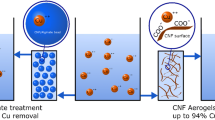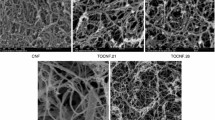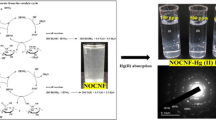Abstract
Exposure to potentially toxic metallic elements (PTME) released in watercourses by industries results in irreversible damage to living beings or even death. The removal of a PTME, such as hexavalent chromium (Cr(VI)) in industrial wastewater aligned with the reuse/modification of natural adsorbents, is a promising alternative to remedy this problem. This paper presents cellulose from eucalyptus by-products at the macro (CMS) and nanoscale (CNS), obtained through a ball-milling process, which were also modified with zirconium oxide, providing MCMS and MCNS, respectively. The samples were characterized by FTIR, TGA, DRX, and adsorption tests. The cellulose chemical structure was maintained after milling and modification, but Zr-O bands’ inclusion indicated the fiber modification. The nanostructure presented a higher modification degree, highlighted by a considerable increase in thermal stability associated with the modified cellulose surface by zirconium. This result was corroborated by XRD analysis that presented new peaks for MCNS and reduced crystallinity. The adsorption test showed that the hydroxyl groups from the cellulose structure could remove Cr(VI) from water. However, this behavior was considerably enhanced by zirconium that increased the available binding sites, especially for the modified nanostructure, which presented the removal of 54% of Cr(VI). These results highlight the potential revaluation of eucalyptus residue and the modification treatment to attain a material with great adsorption properties that could reduce water contamination.
Graphical Abstract







Similar content being viewed by others
Data Availability
The raw/processed data required to reproduce these findings cannot be shared at this time as the data also forms part of an ongoing study.
References
Mushtaq N, Singh DV, Bhat RA, Dervash MA, Hameed O (2020) Fresh water pollution dynamics and remediation. Singapore, Springer Singapore, pp 27–50
Chowdhury A, Kumari S, Khan AA, Hussain S (2020) Selective removal of anionic dyes with exceptionally high adsorption capacity and removal of dichromate (Cr2O72-) anion using Ni-Co-S/CTAB nanocomposites and its adsorption mechanism. J Hazard Mater 385:121602. https://doi.org/10.1016/j.jhazmat.2019.121602
Hashem S (2021) Investigating the principles of water treatment and industrial wastewater. J Eng Ind Res 2:44–55
Qadri H, Bhat RA (2020) The concerns for global sustainability of freshwater ecosystems. Fresh Water Pollut Dyn Remediat. https://doi.org/10.1007/978-981-13-8277-2
Zhang X, Wang T, Xu Z, Zhang L, Dai Y, Tang X, Tao R, Li R, Yang Y, Tai Y (2020) Effect of heavy metals in mixed domestic-industrial wastewater on performance of recirculating standing hybrid constructed wetlands (RSHCWs) and their removal. Chem Eng J 379:122363. https://doi.org/10.1016/j.cej.2019.122363
Osuna-Martínez CC, Armienta MA, Bergés-Tiznado ME, Páez-Osuna F (2021) Arsenic in waters, soils, sediments, and biota from Mexico: an environmental review. Sci Total Environ 752:142062. https://doi.org/10.1016/j.scitotenv.2020.142062
Karaouzas I, Kapetanaki N, Mentzafou A, Kanellopoulos TD, Skoulikidis N (2021) Heavy metal contamination status in Greek surface waters: a review with application and evaluation of pollution indices. Chemosphere 263:128192. https://doi.org/10.1016/j.chemosphere.2020.128192
Yaqub G, Khan A, Ahmad MZ, Irshad U (2021) Determination of concentration of heavy metals in fruits vegetables, groundwater, and soil samples of the cement industry and nearby communities and assessment of associated health risks. J Food Qual. 2021:1–9
Lu N, Hu T, Zhai Y, Qin H, Aliyeva J, Zhang H (2020) Fungal cell with artificial metal container for heavy metals biosorption: equilibrium, kinetics study and mechanisms analysis. Environ Res 182:109061. https://doi.org/10.1016/j.envres.2019.109061
Saini S, Gill JK, Kaur J, Saikia HR, Singh N, Kaur I, Katnoria JK (2020) Biosorption as environmentally friendly technique for heavy metal removal from wastewater. In: Qadri H, Bhat RA, Mehmood MA, Dar GH (eds) Fresh water pollution dynamics and remediation. Springer Singapore, Singapore, pp 167–181
Almomani F, Bhosale R, Khraisheh M, Kumar A, Almomani T (2020) Heavy metal ions removal from industrial wastewater using magnetic nanoparticles (MNP). Appl. Surf. Sci. 506:144924. https://doi.org/10.1016/j.apsusc.2019.144924
Zhao L, Yang S, Yilihamu A, Ma Q, Shi M, Ouyang B, Zhang Q, Guan X, Yang ST (2019) Adsorptive decontamination of Cu2+-contaminated water and soil by carboxylated graphene oxide/chitosan/cellulose composite beads. Environ Res 179:108779. https://doi.org/10.1016/j.envres.2019.108779
Kumar A, Jigyasu DK, Subrahmanyam G, Mondal R, Shabnam AA, Cabral-Pinto MMS, Malyan SK, Chaturvedi AK, Gupta DK, Fagodiya RK, Khan SA, Bhatia A (2021) Nickel in terrestrial biota: Comprehensive review on contamination, toxicity, tolerance and its remediation approaches. Chemosphere 275:129996. https://doi.org/10.1016/j.chemosphere.2021.129996
Yaseen ZM (2021) An insight into machine learning models era in simulating soil, water bodies and adsorption heavy metals: review, challenges and solutions. Chemosphere 277:130126. https://doi.org/10.1016/j.chemosphere.2021.130126
Sánchez-Díaz G, Escobar F, Badland H, Arias-Merino G, de la Paz MP, Alonso-Ferreira V (2018) Geographic analysis of motor neuron disease mortality and heavy metals released to rivers in spain. Int. J. Environ. Res. Public Health 15(11):2522. https://doi.org/10.3390/ijerph15112522
Wang Y, Li M, Wan X, Sun Y, Cheng K, Zhao X, Zheng Y, Yang G, Wang L (2018) Spatiotemporal analysis of PM 2.5 and pancreatic cancer mortality in China. Environ. Res. 164:132–139. https://doi.org/10.1016/j.envres.2018.02.026
Ghosh RE, Freni-Sterrantino A, Douglas P, Parkes B, Fecht D, de Hoogh K, Fuller G, Gulliver J, Font A, Smith RB, Blangiardo M, Elliott P, Toledano MB, Hansell AL (2019) Fetal growth, stillbirth, infant mortality and other birth outcomes near UK municipal waste incinerators; retrospective population based cohort and case-control study. Environ Int 122:151–158. https://doi.org/10.1016/j.envint.2018.10.060
Yang H, Hong M, Chen S (2020) Removal of Cr(VI) with nano-FeS and CMC-FeS and transport properties in porous media. Environ Technol (United Kingdom) 41:2935–2945. https://doi.org/10.1080/09593330.2019.1588921
Othman N, Noah NFM, Sulaiman RNR, Jusoh N, Tan WT (2021) Emulsion liquid membrane modeling for chromium removal from electroplating wastewater using TOMAC as a carrier. Water Environ Res 93:1669–1679. https://doi.org/10.1002/wer.1551
Brasili E, Bavasso I, Petruccelli V, Vilardi G, Valletta A, Bosco CD, Gentili A, Pasqua G, Di Palma L (2020) Remediation of hexavalent chromium contaminated water through zero-valent iron nanoparticles and effects on tomato plant growth performance. Sci Rep 10:1–12. https://doi.org/10.1038/s41598-020-58639-7
Chen N, Qiu G, Huang C, Liu L, Li G, Chen B (2019) Removal of hexavalent chromium in soil by lignin-based weakly acidic cation exchange resin, Chinese. J Chem Eng 27:2544–2550. https://doi.org/10.1016/j.cjche.2019.02.021
Liu L, Liu X, Wang D, Lin H, Huang L (2020) Removal and reduction of Cr(VI) in simulated wastewater using magnetic biochar prepared by co-pyrolysis of nano-zero-valent iron and sewage sludge. J Clean Prod 257:120562. https://doi.org/10.1016/j.jclepro.2020.120562
de la Luz-Asunción M, Pérez-Ramírez EE, Martínez-Hernández AL, Castano VM, Sánchez-Mendieta V, Velasco-Santos C (2019) Non-linear modeling of kinetic and equilibrium data for the adsorption of hexavalent chromium by carbon nanomaterials: dimension and functionalization, Chinese. J Chem Eng 27:912–919. https://doi.org/10.1016/j.cjche.2018.08.024
Nordin N, Asmadi NAA, Manikam MK, Halim AA, Hanafiah MM, Hurairah SN (2020) Removal of hexavalent chromium from aqueous solution by adsorption on palm oil fuel ash (POFA). J Geosci Environ Prot 08:112–127. https://doi.org/10.4236/gep.2020.82008
D. Jia, H. Cai, Y. Duan, J. Xia, J. Guo, Efficient adsorption to hexavalent chromium by iron oxalate modified D301: Characterization, performance and mechanisms, Chinese J. Chem. Eng. (2020) 1–9. https://doi.org/10.1016/j.cjche.2020.06.031.
Mondal NK, Chakraborty S (2020) Adsorption of Cr(VI) from aqueous solution on graphene oxide (GO) prepared from graphite: equilibrium, kinetic and thermodynamic studies. Appl Water Sci 10:1–10. https://doi.org/10.1007/s13201-020-1142-2
Gan L, Geng A, Song C, Xu L, Wang L, Fang X, Han S, Cui J, Mei C (2020) Simultaneous removal of rhodamine B and Cr(VI) from water using cellulose carbon nanofiber incorporated with bismuth oxybromide: the effect of cellulose pyrolysis temperature on photocatalytic performance. Environ Res 185:109414. https://doi.org/10.1016/j.envres.2020.109414
Karri RR, Sahu JN, Meikap BC (2020) Improving efficacy of Cr (VI) adsorption process on sustainable adsorbent derived from waste biomass (sugarcane bagasse) with help of ant colony optimization. Ind Crops Prod 143:111927. https://doi.org/10.1016/j.indcrop.2019.111927
Hu X, Hu Y, Xu G, Li M, Zhu Y, Jiang L, Tu Y, Zhu X, Xie X, Li A (2020) Green synthesis of a magnetic β-cyclodextrin polymer for rapid removal of organic micro-pollutants and heavy metals from dyeing wastewater. Environ Res 180:108796. https://doi.org/10.1016/j.envres.2019.108796
Akter M, Hirase N, Sikder MT, Rahman MM, Hosokawa T, Saito T, Kurasaki M (2021) Pb (II) Remediation from aqueous environment using chitosan-activated carbon-polyvinyl alcohol composite beads. Water Air Soil Pollut. https://doi.org/10.1007/s11270-021-05243-8
Paixão WA, Martins LS, Zanini NC, Mulinari DR (2020) Modification and characterization of cellulose fibers from palm coated by ZrO2·nH2O particles for sorption of dichromate ions. J Inorg Organomet Polym Mater. https://doi.org/10.1007/s10904-019-01415-6
Bendjeffal H, Djebli A, Mamine H, Metidji T, Dahak M, Rebbani N, Bouhedja Y (2018) Effect of the chelating agents on bio-sorption of hexavalent chromium using Agave sisalana fibers, Chinese. J Chem Eng 26:984–992. https://doi.org/10.1016/j.cjche.2017.10.016
de Lima GF, de Souza AG, Bauli CR, da Barbosa RFS, Rocha DB, dos Rosa DS (2019) Surface modification effects on the thermal stability of cellulose nanostructures obtained from lignocellulosic residues. J Therm Anal Calorim. https://doi.org/10.1007/s10973-019-09109-4
Aziz T, Ullah A, Fan H, Ullah R, Haq F, Khan FU, Iqbal M, Wei J (2021) Cellulose nanocrystals applications in health, medicine and catalysis. J Polym Environ 29:2062–2071. https://doi.org/10.1007/s10924-021-02045-1
Souza AG, De Lima GF, Rodrigues RCLB, Cesarino I, Leão AL, Rosa DS (2019) A new approach for conversion of eucalyptus lignocellulosic biomass into cellulose nanostructures: a method that can be applied in industry. J. Nat. Fibers. 18:1501–1511. https://doi.org/10.1080/15440478.2019.1691125
da Silva CG, Kano FS, Rosa DS (2019) Lignocellulosic nanofiber from eucalyptus waste by a green process and their influence in bionanocomposites. Waste Biomass Valorization. https://doi.org/10.1007/s12649-019-00610-3
Costa AWMC, Guerhardt F, Júnior SERR, Cânovas G, Vanale RM, de Freitas DC, Ehrhardt DD, Rosa JM, BasileTambourgi E, Santana JCC, de Souza RR (2020) Biosorption of Cr(VI) using coconut fibers from agro-industrial waste magnetized using magnetite nanoparticles. Environ. Technol. (United Kingdom) 42:35951–3606. https://doi.org/10.1080/09593330.2020.1752812
Ferreira RR, Souza AG, Nunes LL, Shahi N, Rangari VK, dos Rosa DS (2020) Use of ball mill to prepare nanocellulose from eucalyptus biomass: challenges and process optimization by combined method. Mater. Today Commun. 22:100755. https://doi.org/10.1016/j.mtcomm.2019.100755
Tshikovhi A, Mishra SB, Mishra AK (2020) Nanocellulose-based composites for the removal of contaminants from wastewater. Int J Biol Macromol 152:616–632. https://doi.org/10.1016/j.ijbiomac.2020.02.221
Kausar A, Shahzad R, Iqbal J, Muhammad N, Ibrahim SM, Iqbal M (2020) Development of new organic-inorganic, hybrid bionanocomposite from cellulose and clay for enhanced removal of Drimarine Yellow HF-3GL dye. Int J Biol Macromol 149:1059–1071. https://doi.org/10.1016/j.ijbiomac.2020.02.012
Ng NT, Kamaruddin AF, Ibrahim WAW, Sanagi MM, Keyon ASA (2018) Advances in organic–inorganic hybrid sorbents for the extraction of organic and inorganic pollutants in different types of food and environmental samples. J. Sep. Sci. 41:195–208. https://doi.org/10.1002/jssc.201700689
Shen L, Feng S, Li J, Chen J, Li F, Lin H, Yu G (2017) Surface modification of polyvinylidene fluoride (PVDF) membrane via radiation grafting: novel mechanisms underlying the interesting enhanced membrane performance. Sci Rep 7:1–13. https://doi.org/10.1038/s41598-017-02605-3
Paixão WA, Martins LS, Zanini NC, Mulinari DR (2019) Modification and characterization of cellulose fibers from palm coated by ZrO2·nH2O particles for sorption of dichromate ions. J. Inorg. Organomet. Polym. Mater. 30:2591–2597. https://doi.org/10.1007/s10904-019-01415-6
Bashirom N, Tan WK, Kawamura G, Matsuda A, Lockman Z (2020) Comparison of ZrO2, TiO2, and α-Fe2O3 nanotube arrays on Cr(VI) photoreduction fabricated by anodization of Zr, Ti, and Fe foils. Mater. Res. Express. 7:055013. https://doi.org/10.1088/2053-1591/ab8ee3
Rathinam K, Atchudan R, Edison TNJI (2021) Zirconium oxide intercalated sodium montmorillonite scaffold as an effective adsorbent for the elimination of phosphate and hexavalent chromium ions. J. Environ. Chem. Eng. 9:106053. https://doi.org/10.1016/j.jece.2021.106053
Bashirom N, Kian TW, Kawamura G, Matsuda A, Razak KA, Lockman Z (2018) Sunlight activated anodic freestanding ZrO2 nanotube arrays for Cr(VI) photoreduction. Nanotechnology. 29:375701. https://doi.org/10.1088/1361-6528/aaccbd
Mahmoud ME, Abdou AEH, Sobhy ME (2017) Engineered nano-zirconium oxide-crosslinked-nanolayer of carboxymethyl cellulose for speciation and adsorptive removal of Cr(III) and Cr(VI). Powder Tchnol 321:444–453. https://doi.org/10.1016/j.powtec.2017.08.041
Ao H, Cao W, Hong Y, Wu J, Wei L (2020) Adsorption of sulfate ion from water by zirconium oxide-modified biochar derived from pomelo peel. Sci Total Environ 708:135092. https://doi.org/10.1016/j.scitotenv.2019.135092
M.L. Sánchez, W. Patiño, J. Cárdenas, Physical-mechanical properties of bamboo fibers-reinforced biocomposites: Influence of surface treatment of fibers, J. Build. Eng. 28 (2020). https://doi.org/10.1016/j.jobe.2019.101058.
Camani PH, Anholon BF, Toder RR, Rosa DS (2020) Microwave-assisted pretreatment of eucalyptus waste to obtain cellulose fibers. Cellulose. 7:3591–3609. https://doi.org/10.1007/s10570-020-03019-7
de Carvalho JG, Zanini NC, Claro AM, Do Amaral NC, Barud HS, Mulinari DR (2021) Composite filaments OF PHBV reinforced with ZrO2·nH2O particles for 3D printing. Polym Bull 79:2113–2132. https://doi.org/10.1007/s00289-021-03610-3
Zanini NC, Barbosa RFS, de Souza AG, Rosa DS, Mulinari DR (2021) Revaluation of Australian palm residues in polypropylene composites: Statistical influence of fiber treatment. J Compos Mater 55:813–826. https://doi.org/10.1177/0021998320960534
Sánchez-Safont EL, Aldureid A, Lagarón JM, Gamez-Perez J, Cabedo L (2020) Effect of the purification treatment on the valorization of natural cellulosic residues as fillers in phb-based composites for short shelf life applications. Waste Biomass Valorization. https://doi.org/10.1007/s12649-020-01192-1
Tuyet T, Phan M, Ngo TS (2020) Pectin and cellulose extraction from passion fruit peel waste. VJSTE 62:32–37. https://doi.org/10.31276/VJSTE.62(1).32-37
Mohammadkazemi F, Barangenani RK, Koosha M (2019) Development of organic–inorganic oxidized bacterial cellulose nanobiocomposites: ternary complexes. Cellulose. 26:6009–6022. https://doi.org/10.1007/s10570-019-02514-w
Arnata IW, Suprihatin S, Fahma F, Richana N, Sunarti TC (2020) Cationic modification of nanocrystalline cellulose from sago fronds. Cellulose. 3:3121–3141. https://doi.org/10.1007/s10570-019-02955-3
Tong X, Shen W, Chen X, Jia M, Roux JC (2020) Preparation and mechanism analysis of morphology-controlled cellulose nanocrystals via compound enzymatic hydrolysis of eucalyptus pulp. J Appl Polym Sci 137:1–11. https://doi.org/10.1002/app.48407
Eleutério, T., Sério, S., Teodoro, O.M.N.D., Bundaleski, N., Vasconcelos, H.C. (2020) XPS and FTIR studies of dc reactive magnetron sputtered TiO2 thin films on natural based-cellulose fibers 10: 287.
Zhang R, Xie J, Yang B, Fu F, Tang H, Zhang J, Zhao Y, Zhang Y, Liu L, Zhu Y, Liu X, Zhou J, Yao J (2019) Self-assembly of chitosan and cellulose chains into a 3D porous polysaccharide alloy films: co-dissolving, structure and biological properties. Appl Surf Sci 493:1032–1041. https://doi.org/10.1016/j.apsusc.2019.06.193
Jilal I, El-Barkany S, Bahari Z, Sundman O, El-Idrissi A, Abou-Salama M, Loutou M, Ablouh E, Amhamdi H (2019) New benzyloxyethyl cellulose (BEC) crosslinked EDTA: synthesis, characterization and application for supramolecular self-assembling nanoencapsulation of Pb (II). Mater Today Proc 13:909–919. https://doi.org/10.1016/j.matpr.2019.04.055
Campbell S, Bernard FL, Rodrigues DM, Rojas MF, Carreño LÁ, Chaban VV, Einloft S (2019) Performance of metal-functionalized rice husk cellulose for CO2 sorption and CO2/N2 separation. Fuel 239:737–746. https://doi.org/10.1016/j.fuel.2018.11.078
Rezaee R, Montazer M, Mianehro A, Mahmoudirad M (2021) Single-step synthesis and characterization of Zr-MOF onto wool fabric: preparation of antibacterial wound dressing with high absorption capacity. Fibers Polym. https://doi.org/10.1007/s12221-021-0211-y
Son PA, Nishimura S, Ebitani K (2014) Preparation of zirconium carbonate as water-tolerant solid base catalyst for glucose isomerization and one-pot synthesis of levulinic acid with solid acid catalyst. React Kinet Mech Catal 111:183–197. https://doi.org/10.1007/s11144-013-0642-6
Cui Y, Chen Z, Liu X (2016) Preparation of UV-curing polymer-ZrO2 hybrid nanocomposites via auto-hydrolysis sol-gel process using zirconium oxychloride octahydrate coordinated with organic amine. Prog Org Coatings 100:178–187. https://doi.org/10.1016/j.porgcoat.2016.03.028
Waghmare MA, Pawar KS, Pathan HM, Ubale AU (2017) Influence of annealing temperature on the structural and optical properties of nanocrystalline zirconium oxide. Mater Sci Semicond Process 72:122–127. https://doi.org/10.1016/j.mssp.2017.09.036
Phanthong P, Reubroycharoen P, Hao X, Xu G, Abudula A, Guan G (2018) Nanocellulose: extraction and application. Carbon Resour Convers 1:32–43. https://doi.org/10.1016/j.crcon.2018.05.004
Mulinari DR, da Silva MLCP (2008) Adsorption of sulphate ions by modification of sugarcane bagasse cellulose. Carbohydr Polym 74:617–620. https://doi.org/10.1016/j.carbpol.2008.04.014
Musyarofah, Soontaranon S, Limphirat W, Triwikantoro, Pratapa S (2019) XRD, WAXS, FTIR, and XANES studies of silica-zirconia systems. Ceram. Int. 45:15660–15670. https://doi.org/10.1016/j.ceramint.2019.05.078
da Silva DCP, de Menezes LR, da Silva PSRC, Tavares MIB (2019) Evaluation of thermal properties of zirconium–PHB composites. J Therm Anal Calorim. https://doi.org/10.1007/s10973-019-09106-7
Kathirselvam M, Kumaravel A, Arthanarieswaran VP, Saravanakumar SS (2019) Characterization of cellulose fibers in Thespesia populnea barks: Influence of alkali treatment. Carbohydr Polym 217:178–189. https://doi.org/10.1016/j.carbpol.2019.04.063
Peng S, Meng H, Ouyang Y, Chang J (2014) Nanoporous magnetic cellulose-chitosan composite microspheres: Preparation, characterization, and application for Cu(II) adsorption. Ind Eng Chem Res 53:2106–2113. https://doi.org/10.1021/ie402855t
Salari M, Khiabani MS, Mokarram RR, Ghanbarzadeh B, Kafil HS (2018) Development and evaluation of chitosan based active nanocomposite films containing bacterial cellulose nanocrystals and silver nanoparticles. Food Hydrocoll. 84:414–423. https://doi.org/10.1016/j.foodhyd.2018.05.037
Phanthong P, Karnjanakom S, Reubroycharoen P, Hao X, Abudula A, Guan G (2017) A facile one-step way for extraction of nanocellulose with high yield by ball milling with ionic liquid. Cellulose 24:2083–2093. https://doi.org/10.1007/s10570-017-1238-5
Phanthong P, Guan G, Ma Y, Hao X, Abudula A (2016) Effect of ball milling on the production of nanocellulose using mild acid hydrolysis method. J Taiwan Inst Chem Eng 60:617–622. https://doi.org/10.1016/j.jtice.2015.11.001
Fatimah I, Taushiyah A, Najah FB, Azmi U (2018) ZrO2/bamboo leaves ash (BLA) catalyst in biodiesel conversion of rice bran oil. IOP Conf. Ser. Mater. Sci. Eng. 349:012927. https://doi.org/10.1088/1757-899X/349/1/012027
Rushton MJD, Ipatova I, Evitts LJ, Lee WE, Middleburgh SC (2019) Stoichiometry deviation in amorphous zirconium dioxide. RSC Adv 9:16320–16327. https://doi.org/10.1039/c9ra01865d
Naduparambath S, Jinitha TV, Shaniba V, Sreejith MP, Balan AK, Purushothaman E (2018) Isolation and characterisation of cellulose nanocrystals from sago seed shells. Carbohydr. Polym. 180:13–20. https://doi.org/10.1016/j.carbpol.2017.09.088
Barbosa RFS, Souza AG, Maltez HF, Rosa DS (2020) Chromium removal from contaminated wastewaters using biodegradable membranes containing cellulose nanostructures. Chem. Eng. J. 395:125055. https://doi.org/10.1016/j.cej.2020.125055
Liu X, Tian J, Li Y, Sun N, Mi S, Xie Y, Chen Z (2019) Enhanced dyes adsorption from wastewater via Fe3O4 nanoparticles functionalized activated carbon. J Hazard Mater 373:397–407. https://doi.org/10.1016/j.jhazmat.2019.03.103
Ajiboye TO, Oyewo OA, Onwudiwe DC (2021) Simultaneous removal of organics and heavy metals from industrial wastewater: a review. Chemosphere 262:128379. https://doi.org/10.1016/j.chemosphere.2020.128379
Fu D, Kurniawan TA, Avtar R, Xu P, Othman MHD (2021) Recovering heavy metals from electroplating wastewater and their conversion into Zn2Cr-layered double hydroxide (LDH) for pyrophosphate removal from industrial wastewater. Chemosphere. 271:129861. https://doi.org/10.1016/j.chemosphere.2021.129861
Acknowledgements
The authors are grateful for the financial support provided by Fundação de Amparo à Pesquisa do Estado de São Paulo (#2018/11277-7, 2021/08296-2), Fundação de Amparo à Pesquisa do Estado do Rio de Janeiro (E-26/260.026/2018 and E-26/010.001800/2015), and Conselho Nacional de Desenvolvimento Científico e Tecnológico (305819/2017-8). The authors thank the CAPES (Code 001), UFABC, and REVALORES Strategic Unit.
Author information
Authors and Affiliations
Contributions
RFdSB: Conceptualization, writing, investigation, data interpretation. NCZ: Conceptualization, writing, investigation. DRM: Conceptualization, validation, Formal analysis, Review and editing, Funding acquisition. DdSR: Conceptualization, validation, Formal analysis, Review and editing, Funding acquisition, Supervision, Project administration.
Corresponding author
Ethics declarations
Conflict of Interest
The authors declare that they have no competing interests.
Additional information
Publisher's Note
Springer Nature remains neutral with regard to jurisdictional claims in published maps and institutional affiliations.
Rights and permissions
About this article
Cite this article
Barbosa, R.F., Zanini, N.C., Mulinari, D.R. et al. Hexavalent Chromium Sorption by Modified Cellulose Macro and Nanofibers Obtained from Eucalyptus Residues. J Polym Environ 30, 3852–3864 (2022). https://doi.org/10.1007/s10924-022-02469-3
Accepted:
Published:
Issue Date:
DOI: https://doi.org/10.1007/s10924-022-02469-3




